The Intro
The Disappearing Lake
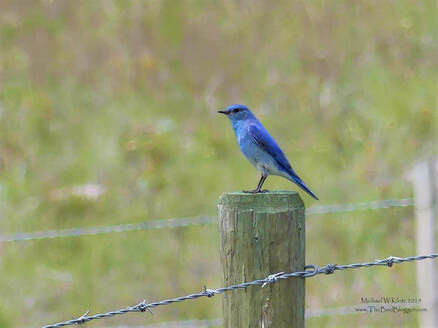 Mountain Bluebird
Mountain Bluebird
The IntroI am always interested in visiting new places and birds are always high on the list of things to see. Meadow Lake Guest Ranch completely exceeded my expectations when It came to birds and biomes with my total count coming to 97 species in 2.5 days. Not only were the birds awesome but so were the log houses and the hospitality. It is very rare that I am able to explore a vast range of habitats and see so many birds in such a small area but this little gem hidden away in the interior of BC was all that and more. The Disappearing Lake Mountain Bluebird Mountain Bluebird Meadow Lake, like so many of the lakes around the area, is a closed system. This means that water typically flows into the lake but not out, with almost all the water leaving by way of the sky. These lakes are usually salty and are sometimes called soda lakes named for the white edges in the summer months. What does this mean for birders? It means a there are birds found here that are rarely found anywhere else in the province of BC. American White Pelicans and American Avocets which are two very rare species found here in the spring and summer months. The lake is not so salty that fish and invertebrates are found here as well. This of course attracts all the regular freshwater birds. There are also micro-climates and different natural features which lend itself to providing homes for a host of other species as well. Examples are the cattail marsh at the east end of the lake and the south facing rolling grass slopes, the pine and spruce forests on the north and mixed in for good measure are the ranch lands and poplar stands. This all translates to GREAT BIRDING.
3 Comments
The Intro
Have you ever been a part of a worldwide event that made a difference to a cause you believe in? This is your chance! The Global Big Day will allow you to make a difference by sharing your backyard birds while at the same time someone is doing the exact same thing in Australia and someone else in Sweden. Let me break the Big Day down for you so you can see how much fun and important it is being part of a worldwide effort to learn more about birds.
The Day
May 5, 2018 ……….. All day ………….24 hours or 10 minutes………... You get the picture. Mark it on your calendar.
The Intro
Most backyard enthusiast want to attract the greatest variety of birds to their outdoor space and one of the easiest ways to do that is by feeding the right seed. Some of these freeloaders will flock to a certain type of seed while others just have a quick look and move on. The seed that you put out, will depend on the time of year, the location in relation to your surrounding vegetation, the hardiness zone, the latitude and who you are looking to show up for dinner. There are several mixed blends of seeds as well as several levels of presentation. There are even special types of seed you want to avoid if you are looking to keep certain critters away.
The Intro
Birds have been one of the greatest sources of enjoyment in my life, besides my family. (My wife sometimes wonders, I know) I share this passion with some 20% of North Americans who spend more than 32 billion dollars on the hobby of watching birds.[i] They are colorful, melodic, comedic, diverse and never too far from where we are. There are many ways to get close to these wonderful animals and one of them is to walk out your back door. You may have a head start in the shape of a space that attracts birds just like it is, or you may have to do some work to get it just right. Be careful, the whole process may become addicting.
The Intro
Ever since I was a little boy I marveled at the aerial speed of hummingbirds as well as the ability to hover for so long. I used to read, in my animal fact books, about how they were the only bird to be able to fly backwards and how the bee hummingbird was the smallest bird in the world and how it could fit entirely in the eyeball of the largest bird in the world. It wasn't until I started watching birds close up that I realized the beauty of the iridescent jewels. I now love to have hummingbirds in the yard and am always interested in knowing more about what would attract them. Obviously, flowers and feeders, but not just any flower will do. We are going to explore some flowering plants, feeders and more which you can add to your outdoor space to increase the chance of having the little flying powerhouses visit you.
The Fake Flower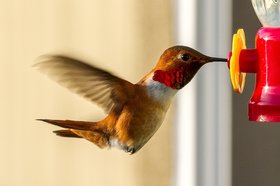
Hummingbirds will take nectar from just about any port in a flower. This makes it very simple to hang a feeder alongside your porch and have the little birds visit. There are a couple items to remember, when setting out a feeder, that are very literally life or death for the hummingbird. The red dyes that are found in the commercial nectars are not good for the health of these guys. The red coloring is used as a marketing gimmick to attract us humans to buy more of the hummer juice. In reality, sugar water is all you need and is made with a 4:1 mixture of water to sugar. This is exactly the same formula as most store-bought elixirs. They do sell clear nectar now which is perfectly fine to feed your guests. The other part of the equation here is, the feeder that the birds are attracted to. The most common are the four-flower, upside down bottle versions, which work very well. Don’t forget to look for a feeder with a moat so that ants are somewhat deterred. Try not to use the yellow cages or flowers like shown in the picture, it only makes a wasp problem worse. Yellow is an attractant for these bothersome freeloaders. It is always nice to have a perch as well, as it gives the bird some rest while restoring energy. Be sure to clean your feeder regularly as a neglected feeder may grow unwanted bacteria and harm the birds. Cleaning should happen twice a week in the warmer weather. See more on Hummingbird Feeders here. Feeders are a great way to keep track of which birds are visiting your yards and gardens. There are 5 common types of Hummingbirds in The United States and Canada and several places in the south have several more. Don't forget to keep a list on eBird!
The Intro
Bird fountains and baths can add amazing sights and sounds to your garden. The water feature itself may hold some captivating beauty, but the birds that visit will be even more stunning. You will be amazed at the amount of visitors your fountain brings to your yard just from the sound of a drop of water. There may be all sorts of birds that will come who may have been as close as the neighbors hedge, but just didn’t have the right reason to visit. Fountains can be as simple as “just add water” or as complex as calling the local pond contractor but they all have a place and they all bring something more to your outside living space including a bird and a smile.
The Location, Location, Location
The Intro
How do you pick a pair of binoculars? If you have unlimited funds and don’t mind carrying a large set of glasses around, it will be easy to choose. For those of us that have a budget and don’t need the night vision, there are still choices. There are more styles of binoculars than a person can count and they come in all manner of different sizes, shapes, quality, optics and price range. Read on and we can sort out what might be right for you while leaving some pennies in your pocket.
The Look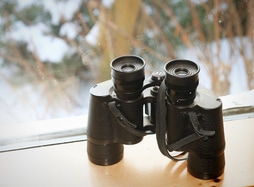
There are small sets of binoculars that are used for sporting events and operas and medium to large size sets that usually sit on a sill to a backyard window, but bigger is not always better when it comes to your optical assistance. The smaller binoculars are very easy to carry around and stow away but the downside is that these are usually not that great for magnification or light. There are the standard sets of binoculars which are the very same ones that you might find on a Boy Scout outing and they are the ones that I started my glamorous bird watching career with. This what you would call the Goldie Locks set, not to big, not to small ………. and you know the rest. There are larger pairs of glasses that allow a good deal of light in due to their large lense openings, but sometimes these can be very bulky. With the introduction of digital, you can view your subjects on a screen or record the image. What ever the look, you want something that fits your needs and the question is, what exactly do you want to do with them?
The Intro
Recently, I shared a couple of videos of cool hummingbird feeders on my webpage. I noticed there was a good deal of interest and questions that came up as we all like to see these little gems up close as they are so fascinating. Everyone has their preferences, but there are somethings that don’t change when it comes to our little feathered friends and what to put out, to bring them into our worl. Hummingbirds have an amazingly fast metabolism and must feed constantly to supply their little bodies with nutrients. This is why they love the quick and ready feeders but they do require more than just sugar water. We all love the buzz of a hummingbird in our gardens and I hope the next part of this story benefits not just you but the little birds that we all love so much.
The Intro
Panama is a beautiful country with a multitude of interesting sights to take in during a visit there, with birding being one of their specialties. The country is about the same land area as West Virginia who has just over 300 species of birds that live or visit there. Panama is home to more than 978 distinct birds and the exciting realization that there are new species in some of the more remote areas. To put that in perspective, there are 914 recognized species in United States and Canada combined! There is a fantastic mix of North and South American birds with some being migratory and others that are resident species. There are also several endemic species which means that they can only be found in within the borders of Panama. The Panama Canal is something to see as the large ships are moving through the locks, but more importantly, you must see the jungles around the canal that have been protected as green spaces and are relatively untouched since the building of the canal. This buffer around the canal is an amazing place to see some of the lowland birds in this tropical country. Other excellent birding areas of the country are the mountains extending out of Costa Rica, the grasslands on the pacific coast, the mountain chain extending out of Columbia, the lowland forests and the vast shoreline on both the Pacific coast and the Atlantic Coast as well as desert climates complete with cacti.
Las Aves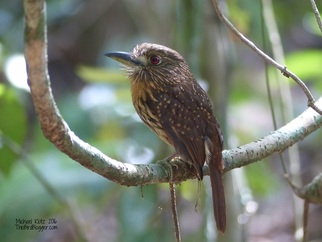
The amazing colors of Panama's Birds are something that you notice immediately, with some of the birds looking like rainbows. There are several different species of Toucan, all with different painted bills, Trogons with their bright colors and pattern coded tails, Hummingbirds with the iridescent feathers only showing when the sun is hitting them just right and the Tanagers filling all colors of the spectrum in all corners of the country. There are birds with cryptic coloration so well camouflaged, they have white speckles on their wings to imitate the look of filtered sunlight sitting on a leaf. Some birds look so similar to a branch that they are undetectable even when passing by within a couple feet. The niches that birds fill here are also incredibly far ranging with that reason being, the diversity of the landscape. There are birds that dwell here that have a special symbiotic relationship with plant species as well and have adapted a bill that is so specialized it is only suited to collecting nectar from a handful of flowers. The beak adaptation matches the length and curve of a flower’s tube virtually making that bird the only pollinator. The are also the Antbirds that have forged a binding relationship with army ants and are found only in the presence of these fierce insects. The Frigate birds, “pirates of the sky” who are canal residents who's main source of food is by stealing from other sea birds. The overwhelming diversity of birds in this little country makes it a birders paradise.
It is pretty tough to find a better vacation spot than Maui. Life is just more relaxed and anyone you meet all seem to have smiles. The birds on Maui however are not on vacation and are busy looking for the necessities in life, just like anywhere else in the world. For such a small area, there are a surprisingly large amount of ecosystems here. This is due to the height of the volcanos, the direction of the prevailing wind, the valleys and lowlands and of course, the ocean surrounding it all. There is bird life everywhere on the island, unfortunately, the native populations gets the short end of the stick. Most of the native birds have gone extinct on the island since the 1700’s. Before that, another massive change when Polynesians landed on the islands somewhere around 400 AD. There are still some fortresses higher up on the island that support the local populations and they are certainly worth the trek. Have a read on what Maui has to offer the fair weather birder. The Beaches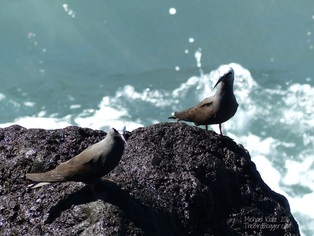 Black Noddy's - Michael Klotz Black Noddy's - Michael Klotz As part of the Hawaiian Islands, Maui is surrounded by ocean water which makes a perfect stop over for any birds that are migrating on to places south or just makes a great home for the winter. There are perfect sandy beaches for the peeps and waders, who probe the sand for buried treasure, like Sanderlings and Curlews. There are also the rocky shores consisting of pitted lava which are the favorite place of birds like the Wandering Tattler and the Ruddy Turnstone. During the breeding months there are birds that use the rocky islands for nesting such as the Black Noddy and occasionally you will see a Booby or two…… the bird variety of course. The Road to Hana offers fantastic places to stop and see the different beaches along the way. |
|
Go Birding Today
|